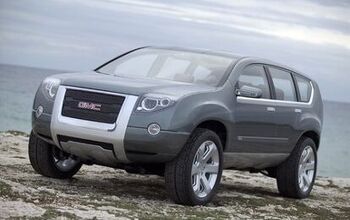General Motors Death Watch 165: The VEBA Fiasco
As GM's fortunes head for their inevitable denouement, it's time to pause and reflect on the deal that revolutionized the American automaker's labor relations. I speak here of the multi-billion dollar bribe paid to the United Auto Workers (UAW) to cut their sky-high wages and benefits down to size. In exchange for a new Voluntary Employees Beneficiary Association (VEBA) health care trust, the union accepted a two-tier wage system. At a stroke, Motown became competitive with the transplants, while the UAW protected its members' health care benefits for all time. In theory.
Until now, analyzing the agreement was impossible. After the strike-busting health care deal was announced in September, GM and the UAW asked for– and received– a legally binding blackout on final negotiations.
Last Thursday, the UAW sued GM in U.S. District Court. The “non-hostile” lawsuit is designed to secure court approval for changes to the union's health care coverage for 500k or so GM retirees and spouses, as well as thousands of current UAW workers. If the court approves, the new health care VEBA will commence in 2011.
Thanks to the suit, crucial details of the deal are finally coming to light. According to court records, GM has agreed to pay $33b to $36.5b into the trust. Although the figure is in line with expectations, it's an epic financial burden.
[For perspective, GM’s current market capitalization is $13.6b. As of December 31, 2007, GM claims that its total current liquidity– cash, marketable securities and readily available assets from the current VEBA– is $27.3 billion.]
At the moment, we don’t know the exact timing or formula for GM’s contribution to the VEBA– other than the fact that it includes varying levels of cash and notes convertible into stock. But we do know that GM has agreed to make up to 20 annual $165m “backstop payments” to the VEBA if its funding level “can’t provide current benefit levels for at least 25 years from the date of the required payment.”
In other words, GM is planning for failure. Of course, they’re not the only ones. According to UAW Vice President Cal Rapson, “Since the money for our benefits will be paid up front, our retirees will have important protections in case of changes in GM's financial condition."
Yes, well, who’s going to protect UAW members from their own union’s malfeasance? Under the terms of the agreement filed with the court, an 11-member committee will run the GM VEBA trust. The court will pick six members; the UAW International President appoints five, who "may be removed or replaced, and a successor designated, at any time by written notice from the UAW International president." All members must adhere to a code of ethics that bars them from holding a “substantial interest” in any company doing business with the trust. There's no word on committee members' compensation.
Supposedly, the fact that a majority of VEBA administrators will be court-appointed “outsiders” will protect union members' health care coverage. Under the trust agreement, participants and beneficiaries will be "reasonably informed as to how the trust's assets are used and cared for" on an annual basis. In practice, one need only look at GM’s Board of Bystanders to understand the pitfalls of relying on "independent" overseers.
And GM’s Board is a model of probity when compared to the UAW's long, sordid history of corruption. The National Legal and Policy Center’s website lists 84 cases of UAW/CAW corruption, involving millions of dollars. The links only go back to 1998, and who knows how many cases of corruption weren't uncovered?
In short, anyone who believes that the UAW will keep its mitts off of the $36.5b VEBA does so in the face of common sense and a firmly established record of criminal behavior.
But even if you discount the possibility that the VEBA may be ransacked by UAW bosses and their cronies, who’s to say that this union-intensive GM VEBA committee will be effective? Lest we forget, GM is paying the trust pennies on the dollar– significantly less than the company's total anticipated health care costs.
There’s only way for the VEBA to maintain the current of health care coverage: improve efficiency. That’s a fancy way of saying the VEBA administration will have to cut costs, either by eliminating waste and fraud or finding new ways to "economize" on members' health care. What are the odds? And what are the odds that health care costs won’t continue to skyrocket, outpacing any efforts to rein them in?
And despite the UAW’s claim that GM’s health care VEBA will be front-loaded to protect union members from a GM Chapter 11, the court records tell a different tale. “Whether benefits or participant contributions would have to be adjusted by the VEBA trustees thereafter will depend on many factors, including whether GM remains financially viable so it can make the required payments on time.”
There’s no question that the UAW – GM VEBA agreement was a game-changer. But it is NOT a game winner. GM's eventual labor cost reduction will not, by itself, lead to competitive products. Meanwhile, UAW members’ health care now depends on its leaders’ integrity AND GM’s business acumen– neither of which should instill confidence in the rank and file who spent their lives building security for themselves and their dependents.
More by Robert Farago
Latest Car Reviews
Read moreLatest Product Reviews
Read moreRecent Comments
- SCE to AUX Over the last 15 years and half a dozen vehicles, my Hyundais and Kias have been pretty cheap to maintain and insure - gas, hybrid, and electric.I hate buying tires - whose cost goes by diameter - and I'm dreading the purchase of new 19s for the Santa Fe.I also have an 08 Rabbit in my fleet, which is not cheap to fix.But I do my own wrenching, so that's the biggest factor.
- MaintenanceCosts '19 Chevy Bolt: Next to nothing. A 12v battery and a couple cabin air filters. $400 over five years.'16 Highlander Hybrid, bought in 2019: A new set of brakes at all four corners, a new PCV valve, several oil changes, and two new 12v batteries (to be fair, the second one wasn't the car's fault - I had the misfortune of leaving it for a month with both third-row interior lights stealthily turned on by my kid). Total costs around $2500 over five years. Coming due: tires.'11 BMW 335i, bought in late 2022: A new HID low beam bulb (requiring removal of the front fascia, which I paid to have done), a new set of spark plugs, replacements for several flaking soft-touch parts, and two oil changes. Total costs around $1600 over a year and a half. Coming due: front main seal (slow leak).'95 Acura Legend, bought in 2015: Almost complete steering and suspension overhauls, timing belt and water pump, new rear brakes, new wheels and tires, new radiator, new coolant hoses throughout, new valve cover gaskets, new PS hoses, new EGR valve assembly, new power antenna, professional paint correction, and quite a few oil changes. Total costs around $12k over nine years. Coming due: timing belt (again), front diff seal.
- SCE to AUX Given this choice - I'd take the Honda Civic Sport Hatchback (CVT). I 'built' mine for $28777.To my eye, the Civic beats the Corolla on looks these days.But for the same money, I can get an Elantra N-Line with 7-speed DCT, 201 HP, and good fuel economy, so I'd rather go for that.
- Kwik_Shift_Pro4X '19 Frontier Pro 4X. Next to nothing. All oil changes are on schedule. Still on original brakes at 79000 miles. Those are due soon. Estimate $1000 all in.
- Dr.Nick The cars seem really expensive with tight back seats and Cadillac was on the list of the highest price gouging dealers coming out of COVID. I don’t understand the combination, shouldn’t they be offering deals if they are not selling?


































Comments
Join the conversation
MPLS, When it comes to bosses, I vote with my feet. I have been my own boss, but figured out I was really working for the government. I plan to go back to work for someone else and let them play with Uncle Sugar and the 50 dwarves. I will make more money without having to spend so much on lawyers and accountants who don't know their jobs worth a flip. If you think your boss is a pain in the butt, try dealing with KPMG. They treat you like crap, and you get to pay them!
"To expand on your CTS example, it has won MT COTY, received a pick over the 2008 3-series and 2008 C-Class from Consumer Reports, IIHS top pick, CNET technology COTY along with numerous design, safety and performance accolades. The specs and options mirror a 5-series with a price that starts $10,000 less. Cadillac is also at the top of the 2007 J.D. Power Dependability Survey behind only Buick and Lexus, which are tied for first place. " ...and not gained them one half of a percent of market share over their competition.